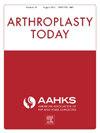Association of Knee Osteoarthritis Treatment Types, Patient Characteristics, and Medical History With Subsequent Risk for Total Knee Arthroplasty: Data From a New Real-World Registry
IF 1.5
Q3 ORTHOPEDICS
引用次数: 0
Abstract
Background
This article examines predictors of subsequent total knee arthroplasty (TKA) within 6 months of nonoperative intervention based on (1) patient demographics; (2) knee osteoarthritis (OA) severity; and (3) various nonoperative treatments (cryoneurolysis with superficial or deep genicular nerve block, intra-articular [IA] hyaluronic acid injections, nonsteroidal inflammatory drug injections, IA-corticosteroids injections, or IA-triamcinolone extended-release [IA-TA-ER] injections).
Methods
Patients who had unilateral knee OA and received nonoperative intervention were identified in the Innovations in Genicular Outcomes Research registry between September 2021 and February 2024, identifying 505 patients. Baseline patient demographics were tabulated by knee OA severity as graded by Kellgren-Lawrence (KL) and nonoperative treatment, identifying patients who underwent TKA within 6 months. Predictors of TKA were identified using 20 potential demographic/clinical variables and calculating individual hazard ratios.
Results
Obesity and KL grade IV knees were significant predictors of TKA within 6 months of nonoperative treatment (P < .05). Age, sex, marital status, number of comorbidities, physical activity level, smoking status, insurance type, and baseline pain and functional scores were not associated with subsequent TKA. Overall, treatment type was also not linked to subsequent TKA, although pairwise comparison suggested use of IA-TA-ER was associated with a decreased conversion to subsequent TKA (P = .002).
Conclusions
Apart from obesity and KL grade IV knees, it remains challenging to identify which patients are at risk for conversion to subsequent TKA after nonoperative treatment. It appears IA hyaluronic acid and IA-TA-ER are most associated with decreased conversion to TKA within 6 months.
求助全文
约1分钟内获得全文
求助全文
来源期刊

Arthroplasty Today
Medicine-Surgery
CiteScore
2.90
自引率
0.00%
发文量
258
审稿时长
40 weeks
期刊介绍:
Arthroplasty Today is a companion journal to the Journal of Arthroplasty. The journal Arthroplasty Today brings together the clinical and scientific foundations for joint replacement of the hip and knee in an open-access, online format. Arthroplasty Today solicits manuscripts of the highest quality from all areas of scientific endeavor that relate to joint replacement or the treatment of its complications, including those dealing with patient outcomes, economic and policy issues, prosthetic design, biomechanics, biomaterials, and biologic response to arthroplasty. The journal focuses on case reports. It is the purpose of Arthroplasty Today to present material to practicing orthopaedic surgeons that will keep them abreast of developments in the field, prove useful in the care of patients, and aid in understanding the scientific foundation of this subspecialty area of joint replacement. The international members of the Editorial Board provide a worldwide perspective for the journal''s area of interest. Their participation ensures that each issue of Arthroplasty Today provides the reader with timely, peer-reviewed articles of the highest quality.
 求助内容:
求助内容: 应助结果提醒方式:
应助结果提醒方式:


